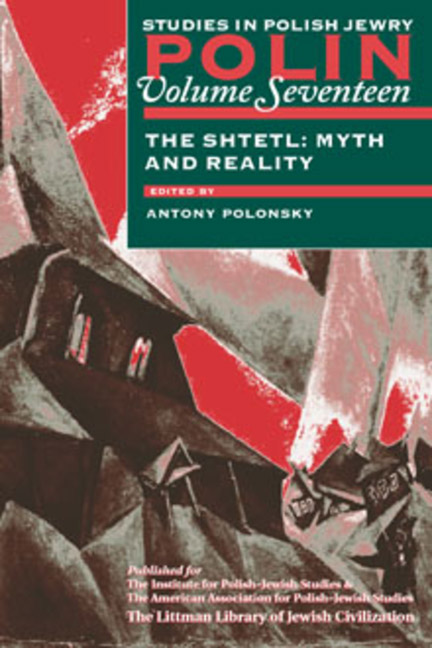Book contents
- Frontmatter
- Dedication
- Editors and Advisers
- Preface
- Polin
- Polin: Studies inPolish Jewry
- Contents
- Note on Place Names
- Note on Transliteration
- List of Abbreviations
- PART I THE SHTETL: MYTH AND REALITY
- Introduction. The Shtetl: Myth and Reality
- The Shtetl as an Arena for Polish–Jewish Integration in the Eighteenth Century
- Inter-Religious Contacts in the Shtetl: Proposals for Future Research
- The Hasidic Conquest of Small-Town Central Poland, 1754–1818
- The Drama of Berdichev: Levi Yitshak and his Town
- Polish Shtetls under Russian Rule, 1772–1914
- How Jewish Was the Shtetl?
- The Changing Shtetl in the Kingdom of Poland during the First World War
- The Shtetl: Cultural Evolution in Small Jewish Towns
- Small Towns in Inter-War Poland
- Jewish Patrons and Polish Clients: Patronage in a Small Galician Town
- Maintaining Borders, Crossing Borders: Social Relationships in the Shtetl
- The Soviet Shtetl in the 1920s
- Shtetl and Shtot in Yiddish Haskalah Drama
- Kazimierz on the Vistula: Polish Literary Portrayals of the Shtetl
- Imagining the Image: Interpretations of the Shtetl in Yiddish Literary Criticism
- Shtetl Codes: Fantasy in the Fiction of Asch, Schulz, and I. B. Singer
- Returning to the Shtetl: Differing Perceptions
- PART II NEW VIEWS
- PART III DOCUMENTS
- PART IV THE SIXTY-FIFTH ANNIVERSARY OF EVENTS IN PRZYTYK: A DEBATE
- PART V REVIEWS
- OBITUARIES
- Notes on the Contributors
- Glossary
- Index
How Jewish Was the Shtetl?
from PART I - THE SHTETL: MYTH AND REALITY
- Frontmatter
- Dedication
- Editors and Advisers
- Preface
- Polin
- Polin: Studies inPolish Jewry
- Contents
- Note on Place Names
- Note on Transliteration
- List of Abbreviations
- PART I THE SHTETL: MYTH AND REALITY
- Introduction. The Shtetl: Myth and Reality
- The Shtetl as an Arena for Polish–Jewish Integration in the Eighteenth Century
- Inter-Religious Contacts in the Shtetl: Proposals for Future Research
- The Hasidic Conquest of Small-Town Central Poland, 1754–1818
- The Drama of Berdichev: Levi Yitshak and his Town
- Polish Shtetls under Russian Rule, 1772–1914
- How Jewish Was the Shtetl?
- The Changing Shtetl in the Kingdom of Poland during the First World War
- The Shtetl: Cultural Evolution in Small Jewish Towns
- Small Towns in Inter-War Poland
- Jewish Patrons and Polish Clients: Patronage in a Small Galician Town
- Maintaining Borders, Crossing Borders: Social Relationships in the Shtetl
- The Soviet Shtetl in the 1920s
- Shtetl and Shtot in Yiddish Haskalah Drama
- Kazimierz on the Vistula: Polish Literary Portrayals of the Shtetl
- Imagining the Image: Interpretations of the Shtetl in Yiddish Literary Criticism
- Shtetl Codes: Fantasy in the Fiction of Asch, Schulz, and I. B. Singer
- Returning to the Shtetl: Differing Perceptions
- PART II NEW VIEWS
- PART III DOCUMENTS
- PART IV THE SIXTY-FIFTH ANNIVERSARY OF EVENTS IN PRZYTYK: A DEBATE
- PART V REVIEWS
- OBITUARIES
- Notes on the Contributors
- Glossary
- Index
Summary
THE image of the shtetl, the quintessential small town of Jewish cultural and political discourse, is that of a small Jewish world imbued with ethnic culture and norms. Even today the shtetl remains one of the more prevalent and popular symbols of Jewish life in the Diaspora. Many people conceive of the shtetl as representing the typical habitat and particular way of life of east European Jewry. Of the many factors that combined to impart to the shtetl its prominence in Jewish discourse, the most important is probably the fact that a significant part of the Jewish people in the last two centuries either had lived in a shtetl or were descendants of people who had. Nevertheless, there is no doubt that Jewish literature, both in Yiddish and in Hebrew, played a central role in propagating the image of the small east European town as a uniquely cohesive Jewish world. Mendele Mokher Seforim, Y. L. Peretz, and Sholem Aleichem, together with a long list of less famous authors, made a major contribution to the popular conception of the shtetl. The influence of their literary images was so pervasive that one could wonder whether discussions of the shtetl were dealing with literary stereotypes and myths or with a real historical and geographic entity. The question of the existence of a stereotypical shtetl could be raised as early as the beginning of the twentieth century, when much of its traditional structure had already disintegrated and many of its sons and daughters had gone overseas. By finally destroying the shtetl, the Russian Revolution, and subsequently the Holocaust, provided the added incentives of nostalgia and guilt to intensify what may be described as the mythical elements in the image of the small town.
The notion that the shtetl was a Jewish town is widely accepted, to the point that it is treated as if this were common knowledge and needed no proof. However, to the best of my knowledge, there has been no scholarly treatment of what in reality constituted the ‘Jewishness’ of those small east European towns. This chapter represents an attempt to define the historical reality and the concrete manifestations that would justify the assertion that these numerous settlements were indeed Jewish towns, and thereby to clarify the role of the shtetls as the territorial base for the culture and history of east European Jewry.
- Type
- Chapter
- Information
- The Shtetl: Myth and Reality , pp. 109 - 118Publisher: Liverpool University PressPrint publication year: 2004



